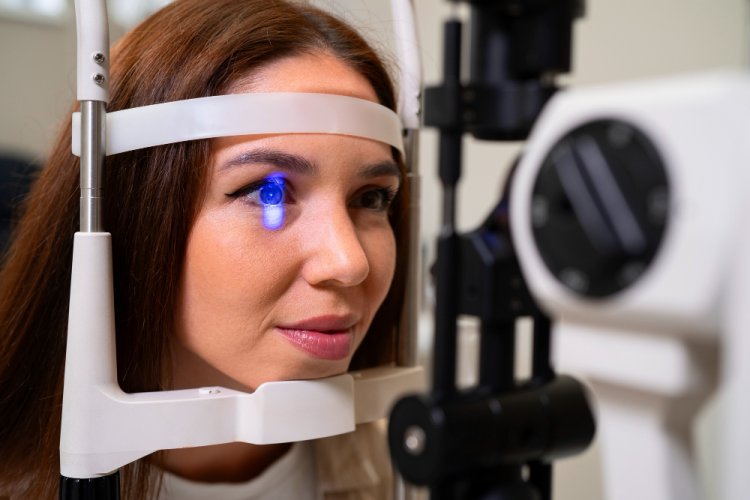Eyes Wide Open: Empowering Knowledge about Glaucoma and Its Prevention
Glaucoma is a progressive optic neuropathy characterized by damage to the optic nerve, often associated with elevated intraocular pressure (IOP). It is a leading cause of irreversible blindness globally, affecting millions of people. Despite its prevalence, glaucoma remains widely misunderstood. This article aims to provide an in-depth exploration of glaucoma, including its causes, symptoms, diagnosis, treatment, and significance in eye health.

Causes
The underlying causes of glaucoma are multifactorial, involving complex interactions between genetic predisposition, anatomical variations in the eye's drainage system, and environmental factors. Elevated intraocular pressure is a significant risk factor for glaucoma, as it can lead to mechanical damage and compression of the optic nerve fibers. However, not all individuals with elevated IOP develop glaucoma, indicating the involvement of additional contributing factors.
Types of Glaucoma
-
Open-angle glaucoma: This is the most common form of glaucoma, characterized by a gradual increase in IOP due to the progressive blockage of the trabecular meshwork, the eye's primary drainage system.
-
Angle-closure glaucoma: This occurs when the drainage angle between the iris and cornea becomes narrowed or blocked, leading to a sudden and severe increase in intraocular pressure.
-
Normal-tension glaucoma: In this subtype, optic nerve damage and visual field loss occur despite IOP measurements within the normal range, suggesting other factors beyond pressure play a role in disease progression.
Symptoms
Glaucoma is often asymptomatic in its early stages, earning it the moniker "the silent thief of sight." However, as the condition progresses, individuals may experience various symptoms, including:
- Gradual loss of peripheral vision, often unnoticed until significant damage has occurred.
- Blurred or hazy vision.
- Halos or rainbow-colored rings around lights.
- Severe eye pain, nausea, and vomiting in acute cases of angle-closure glaucoma.
Importance
Early detection and treatment are paramount in managing glaucoma and preventing irreversible vision loss. Regular eye examinations, particularly for individuals at higher risk, such as those with a family history of glaucoma or individuals over the age of 40, are crucial for early diagnosis and intervention.
Diagnosis
Diagnosing glaucoma involves a comprehensive eye examination and several specialized tests, including:
- Tonometry: Measures intraocular pressure.
- Ophthalmoscopy: Examines the optic nerve for signs of damage.
- Perimetry (Visual Field Test): Evaluates peripheral and central vision.
- Gonioscopy: Assesses the drainage angle of the eye.
- Optical Coherence Tomography (OCT): Provides detailed imaging of the optic nerve and retinal structures.
Treatment
Glaucoma management aims to reduce intraocular pressure and slow disease progression. Treatment options include:
- Medication: Eye drops, oral medications, or combination therapies to lower intraocular pressure by either decreasing fluid production or improving drainage.
- Laser Therapy: Procedures such as selective laser trabeculoplasty (SLT) or laser peripheral iridotomy (LPI) to enhance drainage or reduce fluid production.
- Surgery: Surgical interventions like trabeculectomy or minimally invasive glaucoma surgery (MIGS) to create alternative drainage pathways.
- Lifestyle Modifications: Healthy lifestyle choices, including regular exercise, maintaining a healthy weight, and avoiding smoking, can help manage intraocular pressure and slow disease progression.
In conclusion, Glaucoma poses a significant threat to vision health worldwide, yet early detection and appropriate management can preserve sight and improve quality of life. Understanding the causes, symptoms, diagnosis, and treatment options for glaucoma is essential for both healthcare providers and individuals at risk. By prioritizing regular eye examinations and adopting healthy lifestyle habits, we can work together to combat the silent epidemic of glaucoma and safeguard vision for generations to come.
#GlaucomaAwareness #VisionHealth #EyeCare #OpticNerve #IntraocularPressure #EyeDiseases #BlindnessPrevention #EyeHealthMatters #HealthyVision #EyeExam #GlaucomaTreatment #PreventBlindness #SightSavers #EyeHealthTips #HealthyEyes #Optometry #Ophthalmology #GlaucomaPrevention #EarlyDetection #EyeDiseaseAwareness #VisionLoss #SilentThiefOfSight #EyeConditions #Healthcare #EyeResearch #EyesWideOpen
Disclaimer:
The information provided in this article is for educational purposes only and should not be considered medical advice. If you have any health concerns or are experiencing symptoms, it is important to consult with a healthcare professional, such as a doctor or clinic, for proper diagnosis and treatment. Always seek the advice of your doctor or other qualified health provider with any questions you may have regarding a medical condition. Do not disregard professional medical advice or delay in seeking it because of something you have read in this article.
What's Your Reaction?





















